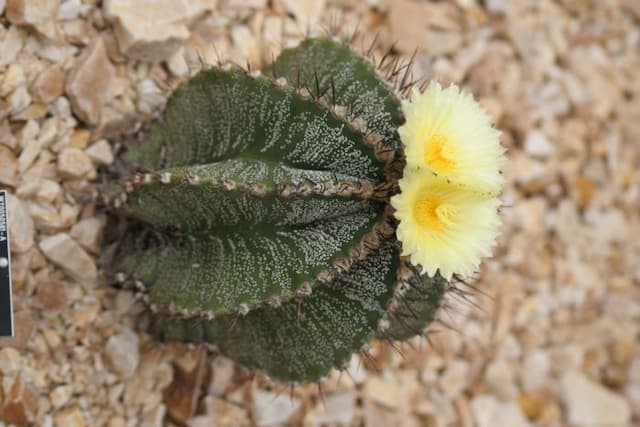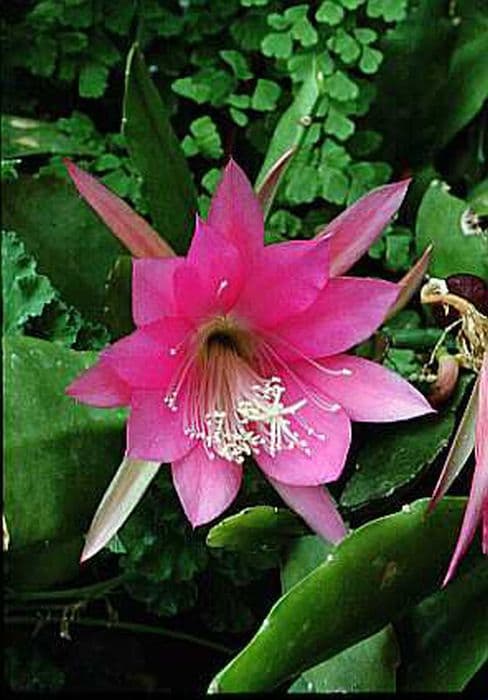Bishop's Cap Cactus Astrophytum ornatum

ABOUT
The Star Cactus is a remarkable succulent that boasts a spherical to columnar shape, its body typically covered in white, woolly areoles that give it a speckled appearance. These areoles are the spots from which spines and flowers emerge. Varying from plant to plant, the number of ribs on the cactus can be quite numerous, often between 8 and 15, running vertically along its body and giving it a unique, sculptural aspect. The spines are quite pronounced, ranging in color from yellow to brown, and they adorn the cactus's ribs with a geometric precision. During the blooming season, the Star Cactus produces striking flowers on the crown, which are notable for their vibrant yellow hue, providing a striking contrast against the green to blue-green body of the cactus. These flowers can be quite large relative to the plant's body, adding a captivating display to the already intriguing plant. Overall, the visual appeal of the Star Cactus lies in its combination of structured ribbing, contrasting white areoles, and the seasonal flourish of its vivid yellow flowers.
About this plant
 Names
NamesFamily
Cactaceae.
Synonyms
Bishop's Cap, Monk's Hood, Star Cactus, Monk's Cap.
Common names
Astrophytum ornatum var. glabrescens, Astrophytum ornatum var. mirbelii, Echinocactus ornatus.
 Toxicity
ToxicityTo humans
The plant known as the Star cactus (Astrophytum ornatum) is not regarded as toxic to humans. There are no well-documented symptoms of poisoning because it is not commonly consumed or known to be poisonous. However, it is always advisable to avoid ingesting plants not intended for consumption as individual reactions can vary.
To pets
The Star cactus is not known to be toxic to pets. It is unlikely to cause poisoning or adverse reactions if pets come into contact with or ingest parts of the plant. Nonetheless, pets should not be encouraged to eat ornamental plants as they may cause gastrointestinal upset or other issues due to non-toxic irritants.
 Characteristics
CharacteristicsLife cycle
Perennials
Foliage type
Evergreen
Color of leaves
Green
Flower color
Yellow
Height
3 feet (0.91 meters)
Spread
1 foot 6 inches (0.46 meters)
Plant type
Cactus
Hardiness zones
9
Native area
Mexico
Benefits
 General Benefits
General Benefits- Decorative Value: Astrophytum ornatum, commonly referred to as the Bishop's Cap, is an ornamental plant with a unique appearance, characterized by its spherical to columnar shape and ribbed body, making it an attractive addition to gardens and indoor spaces.
- Drought Tolerance: As a cactus species, the Bishop's Cap is highly tolerant to drought, requiring minimal watering and maintenance, making it ideal for dry climates and water-wise gardens.
- Easy Propagation: It can be easily propagated from seeds or offsets, enabling gardeners to produce multiple plants from a single specimen, which can be shared or used to populate larger areas.
- Heat Resistance: The Bishop's Cap thrives in high temperatures and full sunlight, making it suitable for warm climates and sunny locations where other plants might struggle.
- Educational Interest: As an interesting specimen of the cactus family, it can be used for educational purposes, teaching about plant adaptations, desert ecosystems, and horticulture.
- Low Maintenance: Requiring minimal care beyond occasional watering and feeding, the Bishop's Cap is an ideal choice for novice gardeners or those with limited time to dedicate to plant care.
- Pest Resistance: This cactus is less prone to pests than many other houseplants, reducing the need for chemical treatments and making it a healthier choice for the home environment.
- Long Lifespan: With proper care, Astrophytum ornatum can live for many years, even decades, making it a long-term addition to any collection or landscape.
- Soil Adaptability: It can adapt to a variety of soil types, as long as they are well-draining, affording flexibility in terms of planting location.
- Compact Growth: Its relatively slow and compact growth habit makes it suitable for container gardening, enabling it to be easily moved or kept in smaller spaces without requiring repotting too often.
 Medical Properties
Medical PropertiesThis plant is not used for medical purposes.
 Air-purifying Qualities
Air-purifying QualitiesThis plant is not specifically known for air purifying qualities.
 Other Uses
Other Uses- Astrophytum ornatum, commonly known as the Bishop's Cap Cactus, can be used as a natural barrier or fence due to its spiny exterior, which can deter animals and unauthorized access to private properties.
- The unique geometric patterns and star-like appearance of the Bishop's Cap Cactus make it a popular subject for botanical illustrations and plant-themed art pieces.
- Bishop's Cap Cactus is used in minimalist and modern landscape designs, offering an architectural element to rockeries and xeriscapes with its distinctive ribbed body.
- Astrobiology researchers may utilize the Bishop's Cap Cactus as a model organism to understand extremophile survival, due to its ability to thrive in harsh, arid conditions similar to those found on other planets.
- The plant is incorporated into educational programs focusing on desert ecology and plant adaptation, helping students understand how species like the Bishop's Cap Cactus have evolved to conserve water and survive intense sunlight.
- In some cultures, the Bishop's Cap Cactus is used in spiritual and religious ceremonies as a symbol of resilience and adaptation to harsh environments.
- The patterned skin of the plant can be used to create unique textures in mold-making for crafts, replicating its surface for decorative purposes in items like candles and pottery.
- Enthusiasts of feng shui may place the Bishop's Cap Cactus in specific areas of the home or office to add a sense of balance and harmony with its symmetrical shape.
- With its slow-growing nature and low water requirements, the Bishop's Cap Cactus serves as a living example of sustainable gardening practices.
- The Bishop's Cap Cactus can feature in macro photography projects, where its detailed areoles and spines are used to teach about depth, texture, and composition in close-up photography.
Interesting Facts
 Feng Shui
Feng ShuiThe Bishop's Cap Cactus is not used in Feng Shui practice.
 Zodiac Sign Compitability
Zodiac Sign CompitabilityThe Bishop's Cap Cactus is not used in astrology practice.
 Plant Symbolism
Plant Symbolism- Uniqueness: Often referred to by its most common name, the Bishop's Cap Cactus, Astrophytum ornatum exhibits a distinctive star-like shape which stands out among other cacti, symbolizing uniqueness and individuality.
- Resilience: As a cactus, the Bishop's Cap is adapted to thrive in harsh, arid environments, making it a symbol of endurance and the ability to withstand challenges.
- Beauty in Simplicity: The Bishop's Cap Cactus, with its geometric patterns and lack of showy flowers, represents the beauty that can be found in simplicity and minimalism.
- Purity: The cactus is often associated with purity because of its white, woolly areas that can be seen as a symbol of innocence and cleanliness.
- Adaptability: This cactus's ability to survive in poor soils and with minimal water is symbolic of adaptability and the capacity to make the most out of limited resources.
- Protection: The spines of the Bishop's Cap Cactus serve as protection from predators and the elements, representing defense and the need to guard oneself against adversity.
- Conservation: Due to habitat destruction and overcollection, some species of Astrophytum have become rare, making the plant a symbol of conservation and the preservation of nature.
- Patience: Cacti generally grow slowly, symbolizing patience and the understanding that some things take time to come to fruition.
- Longevity: As many cacti live for a very long time, the Bishop's Cap can symbolize longevity and a long life well-lived.
 Water
WaterThe Bishop's Cap cactus should be watered sparingly, allowing the soil to completely dry out between watering sessions. Typically, watering once every two to three weeks during active growth periods (spring and summer) is sufficient, using about 8-12 ounces of water, depending on the size of the pot. During the dormant winter months, reduce watering frequency to once a month or less. Always avoid waterlogging as it can lead to root rot. Pour the water directly onto the soil near the base of the plant, without wetting the cactus body.
 Light
LightThe Bishop's Cap cactus thrives in bright light conditions and should be placed in a spot where it can receive full sun to partial shade. Ideally, it should be exposed to several hours of direct sun daily. An east or south-facing windowsill where sunlight is abundant would be an optimal spot for this cactus.
 Temperature
TemperatureThe Bishop's Cap cactus prefers warm temperatures, with ideal conditions ranging between 70 to 80 degrees Fahrenheit. It can survive minimum temperatures of 50 degrees Fahrenheit but should be kept away from frost, which could be damaging. Ensure it is protected during the coldest months and try to maintain a steady warm temperature in its environment.
 Pruning
PruningThe Bishop's Cap cactus generally requires minimal pruning, primarily for the removal of any dead or damaged spines or parts of the cactus. Pruning is typically done in the springtime, just before the growing season begins. Careful handling is required, using gloves and sterile instruments, to avoid damaging the plant or introducing infections.
 Cleaning
CleaningAs needed
 Soil
SoilThe Bishop's Cap cactus thrives in a well-draining cactus mix with coarse sand and pumice or perlite. Aim for a soil pH between 6.0 and 7.5. Incorporate organic material to enrich the mix.
 Repotting
RepottingThe Bishop's Cap cactus should be repotted every 2-3 years, or more frequently if it outgrows its pot. Use a fresh cactus soil mix when repotting.
 Humidity & Misting
Humidity & MistingThe Bishop's Cap cactus prefers low humidity conditions, typical of arid environments. Aim for humidity levels below 50% for optimal growth.
 Suitable locations
Suitable locationsIndoor
Place Bishop's Cap in bright, indirect light and avoid overwatering.
Outdoor
Ensure full sun to partial shade and protect from heavy rainfall.
Hardiness zone
9-11 USDA
 Life cycle
Life cycleCommonly known as the Star Cactus, Astrophytum ornatum begins its life cycle as a seed which germinates in well-drained soil with adequate warmth and light. Once the seedling emerges, it grows slowly, developing a spherical shape that elongates into a columnar cactus over time. During its juvenile phase, the plant displays prominent ribs and may have white woolly areoles from which spines emerge. As it matures, the Star Cactus may bloom in the summer, producing yellow flowers at the top of the cactus, requiring pollinators such as bees for successful fertilization. After pollination, the flowers develop into small, dry fruit containing seeds that can be dispersed to start new plants, thereby continuing its life cycle. This cactus is slow-growing but can live for several decades, reaching heights of up to 6 feet or more in ideal conditions.
 Propogation
PropogationPropogation time
Spring-Early Summer
Astrophytum ornatum, commonly known as the Bishop's Cap Cactus, is most commonly propagated through seeds. The best time to sow the seeds is during spring or summer when the temperature is warm, which is conducive for germination. To propagate Bishop's Cap Cactus by seeds, fill a pot with a well-draining cactus mix and scatter the seeds over the soil surface. Lightly cover them with a thin layer of soil or sand and keep the medium moist by regularly misting it with water. Place the pot in a warm location with bright, indirect sunlight. Seedlings may appear within a few weeks to a couple of months, depending on temperature and moisture conditions. Once they have grown enough to handle, usually when a few sets of true spines have developed, they can be carefully transplanted into individual pots.









